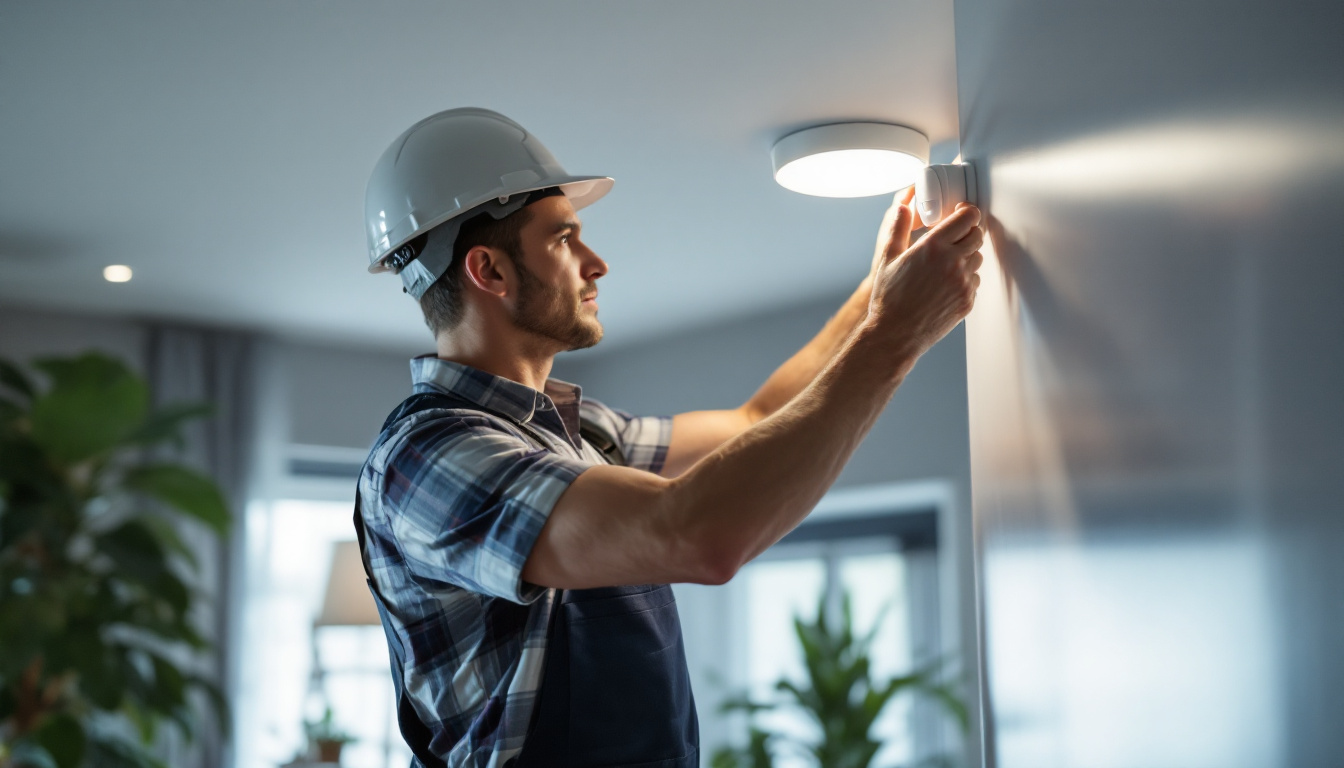
In the ever-evolving field of outdoor lighting, motion sensor switches have become a staple for enhancing security and energy efficiency. For lighting contractors, understanding the intricacies of these devices is crucial to avoid common pitfalls and ensure client satisfaction. This article delves into the essential aspects of outdoor motion sensor switches and provides insights on how contractors can navigate potential issues effectively.
Outdoor motion sensor switches are designed to detect movement and automatically turn on lights, providing convenience and security. They are particularly beneficial in residential and commercial settings, where safety is a priority. However, contractors must be well-versed in the types and functionalities of these switches to make informed recommendations to clients.
There are several types of motion sensors available on the market, each with unique features and applications. The most common types include passive infrared (PIR), microwave, and dual technology sensors. Understanding the differences between these types is essential for selecting the right sensor for specific installations.
PIR sensors are the most widely used due to their reliability and cost-effectiveness. They detect heat emitted by moving objects, making them ideal for outdoor applications. Microwave sensors, on the other hand, emit microwave signals and can detect movement through obstacles, offering a broader coverage area. Dual technology sensors combine both PIR and microwave technologies, minimizing false alarms while maximizing detection capabilities.
When selecting motion sensor switches, several key features should be taken into account. Sensitivity settings, detection range, and adjustable time delays are critical factors that can influence the performance of the sensor. Sensitivity settings allow contractors to customize the sensor’s responsiveness to movement, which is particularly important in areas with high foot traffic or wildlife activity.
Detection range is another vital consideration. Contractors should assess the area where the sensor will be installed to ensure that it provides adequate coverage. Adjustable time delays enable users to set how long the lights remain on after detecting motion, enhancing energy efficiency and reducing unnecessary light pollution.
In addition to these features, weather resistance is a crucial aspect that should not be overlooked. Outdoor motion sensor switches must be designed to withstand various environmental conditions, such as rain, snow, and extreme temperatures. Many models come with an IP (Ingress Protection) rating, which indicates their level of protection against dust and moisture. A higher IP rating signifies a more robust design, making it suitable for outdoor installations where exposure to the elements is inevitable. Furthermore, some advanced models offer smart technology integration, allowing users to control the sensors remotely through mobile applications, providing an added layer of convenience and flexibility in managing outdoor lighting.
Another important consideration is the installation process. Some motion sensor switches are designed for easy DIY installation, while others may require professional assistance. Understanding the installation requirements can help contractors guide their clients effectively, ensuring that the sensors are positioned optimally for maximum efficiency. Proper placement is essential, as factors such as height, angle, and proximity to potential obstructions can significantly affect the sensor’s performance. By taking the time to evaluate these elements, contractors can help clients achieve the best possible results from their outdoor motion sensor switches.
Despite their advantages, outdoor motion sensor switches can present challenges if not installed or configured correctly. Lighting contractors must be aware of these potential issues to mitigate risks and ensure successful installations.
One of the most common issues associated with motion sensor switches is false alarms. These can occur due to environmental factors, such as moving branches, passing animals, or even changes in temperature. To minimize false alarms, contractors should carefully assess the installation location and consider factors like wind direction and nearby vegetation.
Additionally, selecting the right sensitivity settings is crucial. A sensor that is too sensitive may trigger unnecessarily, leading to frustration for clients. Educating clients on how to adjust these settings can also empower them to manage their lighting systems effectively. For instance, some advanced models come with customizable zones, allowing users to specify which areas should be monitored for motion, thus reducing the likelihood of false triggers from benign movements.
Inconsistent performance can be another challenge. Factors such as power supply issues, poor weather conditions, and incorrect installation can lead to unreliable operation. Contractors should ensure that the wiring is correctly connected and that the sensor is positioned optimally to avoid obstructions.
Regular maintenance and testing of the motion sensor switches can help identify and rectify performance issues before they become significant problems. Encouraging clients to conduct periodic checks can enhance the longevity and reliability of the system. Furthermore, educating clients about the importance of keeping the sensor lens clean and free from debris can also significantly improve performance. Dust, cobwebs, and other obstructions can hinder the sensor’s ability to detect motion accurately, leading to missed activations or unnecessary delays in lighting response.
Another critical aspect to consider is the power source for motion sensor switches. Battery-operated models may face challenges related to battery life, especially in colder climates where battery performance can diminish. Contractors should discuss the pros and cons of battery versus hardwired systems with clients, ensuring they choose a solution that fits their needs and environmental conditions. Hardwired systems, while often more reliable, can also be susceptible to power outages or surges, which may require the installation of surge protectors to safeguard the equipment.
Moreover, it is essential to inform clients about the signs of low battery life, such as dimming lights or inconsistent sensor activation. Providing a simple maintenance schedule can help clients stay on top of battery replacements or power checks, ensuring their outdoor lighting remains functional and effective throughout the year.
Proper installation is key to maximizing the effectiveness of outdoor motion sensor switches. By adhering to best practices, lighting contractors can avoid many of the common issues associated with these devices.
Choosing the right location for motion sensor switches is critical. Sensors should be installed at a height that allows for maximum detection while minimizing the likelihood of false triggers. Generally, a height of 6 to 8 feet is recommended, as this range effectively captures movement while reducing interference from small animals or environmental factors.
It is also advisable to position sensors away from direct sunlight, as excessive heat can affect their performance. Additionally, avoiding areas with heavy foliage or other obstructions will enhance the sensor’s ability to detect movement accurately. For instance, placing sensors near pathways or driveways where foot or vehicle traffic is expected can significantly improve their functionality. Furthermore, considering the angle of detection is essential; sensors should be oriented to cover the most frequently used areas without being obstructed by walls or fences.
Ensuring a reliable power supply is essential for the consistent operation of motion sensor switches. Contractors should use appropriate gauge wiring and ensure that all connections are secure and weatherproof. Utilizing outdoor-rated wiring can prevent issues related to moisture and temperature fluctuations.
Moreover, it is wise to consider the power source’s capacity. If multiple sensors are being installed, ensuring that the power supply can handle the load is crucial to avoid circuit overloads and potential failures. In addition to this, implementing surge protection can safeguard the system against voltage spikes caused by lightning or power surges, which can otherwise damage the sensors. It’s also beneficial to label all wiring clearly, as this can simplify troubleshooting and maintenance in the future, ensuring that any necessary repairs can be carried out swiftly and efficiently.
Educating clients about their outdoor motion sensor switches can significantly enhance their experience and satisfaction. Providing clear instructions on how to operate and maintain the system can empower clients to troubleshoot minor issues independently.
During the installation process, contractors should take the time to demonstrate the features and functions of the motion sensor switches. This includes showing clients how to adjust sensitivity settings, change time delays, and troubleshoot common problems. A hands-on demonstration can help clients feel more comfortable with their new system.
Providing written instructions or a user manual can also be beneficial. This allows clients to refer back to the material if they encounter any issues or have questions in the future.
Establishing a support system for clients can enhance their overall experience. Offering follow-up consultations or check-ins can help address any concerns that may arise after installation. Providing a contact number or email for support can also reassure clients that they have access to assistance whenever needed.
Encouraging clients to reach out with questions or concerns fosters a positive relationship and can lead to repeat business and referrals. A satisfied client is often the best advertisement for a contractor’s services.
Outdoor motion sensor switches are invaluable tools for enhancing security and energy efficiency in various settings. However, lighting contractors must be well-informed about the potential issues and best practices associated with these devices. By understanding the different types of sensors, common challenges, and installation techniques, contractors can provide exceptional service and ensure client satisfaction.
Ultimately, the key to success lies in a combination of technical knowledge, effective communication, and ongoing support. By prioritizing these elements, lighting contractors can navigate the complexities of outdoor motion sensor switches and deliver high-quality installations that meet their clients’ needs.
Ready to elevate your lighting projects with the best outdoor motion sensor switches on the market? Look no further than LumenWholesale, where we provide contractors with superior, spec-grade lighting products at unbeatable wholesale prices. Our selection is designed to meet the highest industry standards, ensuring you deliver reliable and high-performance lighting solutions to your clients. Plus, with free shipping on bulk orders, you can stock up on quality lighting without the hidden fees or compromises. Don’t let inflated markups dim your project’s potential. Experience the perfect blend of quality, affordability, and convenience today by visiting Wholesale Lighting at the Best Value and make your next installation a shining success.

Discover essential tips and expert insights for lighting contractors on mastering light automatic sensors.

Discover how LED shop lighting is revolutionizing the future of lighting design and installation.
Discover the essentials of recessed downlights and what clients expect lighting contractors to know.

Discover essential insights into various light bulb types with our comprehensive guide tailored for lighting contractors.